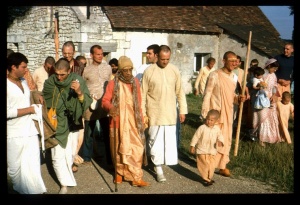CC Adi 2.12 (1975): Difference between revisions
(Vanibot #0027: CCMirror - Mirror CC's 1996 edition to form a basis for 1975) |
(Vanibot #0020: VersionCompareLinker - added a link to the Version Compare feature) |
||
| Line 2: | Line 2: | ||
<div style="float:left">'''[[Sri Caitanya-caritamrta (1975)|Śrī Caitanya-caritāmṛta (1975)]] - [[CC Adi (1975)|Ādi-līlā]] - [[CC Adi 2 (1975)|Chapter 2: Śrī Caitanya Mahāprabhu Is the Supreme Personality of Godhead]]'''</div> | <div style="float:left">'''[[Sri Caitanya-caritamrta (1975)|Śrī Caitanya-caritāmṛta (1975)]] - [[CC Adi (1975)|Ādi-līlā]] - [[CC Adi 2 (1975)|Chapter 2: Śrī Caitanya Mahāprabhu Is the Supreme Personality of Godhead]]'''</div> | ||
<div style="float:right">[[File:Go-previous.png|link=CC Adi 2.11 (1975)|Ādi-līlā 2.11]] '''[[CC Adi 2.11 (1975)|Ādi-līlā 2.11]] - [[CC Adi 2.13 (1975)|Ādi-līlā 2.13]]''' [[File:Go-next.png|link=CC Adi 2.13 (1975)|Ādi-līlā 2.13]]</div> | <div style="float:right">[[File:Go-previous.png|link=CC Adi 2.11 (1975)|Ādi-līlā 2.11]] '''[[CC Adi 2.11 (1975)|Ādi-līlā 2.11]] - [[CC Adi 2.13 (1975)|Ādi-līlā 2.13]]''' [[File:Go-next.png|link=CC Adi 2.13 (1975)|Ādi-līlā 2.13]]</div> | ||
{{CompareVersions|CC|Adi 2.12|CC 1975|CC 1996}} | |||
{{RandomImage}} | {{RandomImage}} | ||
==== TEXT 12 ==== | ==== TEXT 12 ==== | ||
| Line 18: | Line 17: | ||
<div class="synonyms"> | <div class="synonyms"> | ||
tāṅhāra-His; aṅgera-of the body; śuddha-pure; kiraṇa-of rays; maṇḍala-realm; upaniṣat-the Upaniṣads; kahe-say; tāṅre-unto that; brahma-Brahman; su-nirmala-transcendental. | |||
</div> | </div> | ||
| Line 32: | Line 31: | ||
<div class="purport"> | <div class="purport"> | ||
Three mantras of the Muṇḍaka Upaniṣad (2.2. | Three mantras of the Muṇḍaka Upaniṣad (2.2.9-11) give information regarding the bodily effulgence of the Supreme Personality of Godhead. They state: | ||
:hiraṇmaye pare kośe virajaṁ brahma niṣkalam | :hiraṇmaye pare kośe virajaṁ brahma niṣkalam | ||
Latest revision as of 16:54, 26 January 2020

A.C. Bhaktivedanta Swami Prabhupada
TEXT 12
- tāṅhāra aṅgera śuddha kiraṇa-maṇḍala
- upaniṣat kahe tāṅre brahma sunirmala
SYNONYMS
tāṅhāra-His; aṅgera-of the body; śuddha-pure; kiraṇa-of rays; maṇḍala-realm; upaniṣat-the Upaniṣads; kahe-say; tāṅre-unto that; brahma-Brahman; su-nirmala-transcendental.
TRANSLATION
What the Upaniṣads call the transcendental, impersonal Brahman is the realm of the glowing effulgence of the same Supreme Person.
PURPORT
Three mantras of the Muṇḍaka Upaniṣad (2.2.9-11) give information regarding the bodily effulgence of the Supreme Personality of Godhead. They state:
- hiraṇmaye pare kośe virajaṁ brahma niṣkalam
- tac chubhraṁ jyotiṣāṁ jyotis tad yad ātma-vido viduḥ
- na tatra sūryo bhāti na candra-tārakaṁ
- nemā vidyuto bhānti kuto ’yam agniḥ
- tam eva bhāntam anubhāti sarvaṁ
- tasya bhāsā sarvam idaṁ vibhāti
- brahmaivedam amṛtaṁ purastād brahma
- paścād brahma dakṣiṇataś cottareṇa
- adhaś cordhvaṁ ca prasṛtaṁ brahmai-
- vedaṁ viśvam idaṁ variṣṭham
"In the spiritual realm, beyond the material covering, is the unlimited Brahman effulgence, which is free from material contamination. That effulgent white light is understood by transcendentalists to be the light of all lights. In that realm there is no need of sunshine, moonshine, fire or electricity for illumination. Indeed, whatever illumination appears in the material world is only a reflection of that supreme illumination. That Brahman is in front and in back, in the north, south, east and west, and also overhead and below. In other words, that supreme Brahman effulgence spreads throughout both the material and spiritual skies."